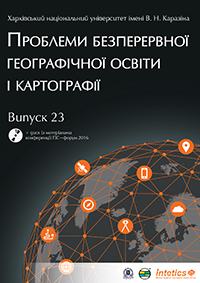Revealing Moscow surface urban heat island using thermal infrared images acquired by resource satellites
Abstract
In this paper we present the analysis of the seasonal variability of the Moscow urban heat island according to instrumental observations at meteorological stations (data of meteorological stations MSU, Balchug, VDNH, and a number of stations in Moscow oblast and its neighborhoods were analyzed) and thermal infrared satellite images (images acquired by TIRS system, satellite Landsat 8 were used). The digital number values of the thermal images are translated into values of land surface temperature. A comparison of the land surface temperature values obtained by thermal satellite images and the values of the atmospheric air temperature and the surface measured according to standard procedures at meteorological stations has been made. The authors revealed the climatic reasons that strengthen Moscow urban heat island: this is due primarily to the positive anomalies of atmospheric pressure, and anomalies of the thermal regime have no effect on the intensity of the phenomenon. Maximum Moscow urban heat island magnitude (slightly more than 3°C for the air temperature and about 15°C for surface temperature), its internal structure and its spatial and temporal variability were estimated - during the analyzed period, the maximum surface urban heat island identified on thermal satellite images was observed in winter, and the maximum urban heat island – in summer. The applicability of the TIRS images for the Moscow urban heat island study was also examined.
Downloads
References
2. Книжников Ю. Ф. Аэрокосмические исследования динамики географических явлений / Ю. Ф. Книжников, В. И. Кравцова. – М.: Изд-во Моск. ун-та, 1991. – 206 с.
3. Справочник эколого-климатических характеристик Москвы (по наблюдениям метеорологической обсерватории МГУ). Том 1 / [под ред. А. А. Исаева]. – М.: Изд-во Моск. ун-та, 2003. – 302 с.
4. Atmospheric Correction Parameter Calculator [Електронний ресурс]. – Режим доступу: http://atmcorr.gsfc.nasa.gov/ (дата звернення: 08.03.2016).
5. Chudnovsky A. Diurnal thermal behavior of selected urban objects using remote sensing measurements / A. Chudnovsky, E. Ben-Dor, H. Saaroni // Energy and Buildings. – 2004. – Vol. 36. – P. 1063-1074.
6. Dousset B. Satellite multi-sensor data analysis of urban surface temperatures and landcover / B. Dousset, F. Gourmelon // ISPRS Journal of Photogrammetry & Remote Sensing. – 2003. – Vol. 58. – P. 43–54.
7. Hung T. Assessment with satellite data of the urban heat island effects in Asian mega cities / T. Hung, D. Uchihama, S. Ochi, Y. Yasuoka // International Journal of Applied Earth Observation and Geoinformation. – 2006. – Vol. 8. – P. 34–48.
8. Kukanova E. A. An urban heat islands climatology in Russia and linkages to the climate change / E. A. Kukanova, P. I. Konstantinov // Geophysical Research Abstracts of EGU General Assembly. – 2014. – Vol. 16. – P. 10833.
9. Landsat 8 (L8) Data Users Handbook. Version 1.0. June 2015. – Sioux Falls, South Dakota : EROS, 2015. – 106 p.
10. Oke T. R. Boundary layer climates. Second edition. – 1987. – 435 p.
11. Poglio T. OSIrIS: a physically based simulation tool to improve training in thermal infrared remote sensing over urban areas at high spatial resolution / T. Poglio, S. Mathieu-Marni, T. Ranchin, E. Savaria, L. Wald // Remote Sensing of Environment. – 2006. – Vol. 104. – P. 238-246.
12. Sobrino J. A. Land surface temperature retrieval from Landsat-5/TM / J. A. Sobrino, J. C. Jimenez-Munoz, L. Paolini // Remote Sensing of Environment. – 2004. – Vol. 90. – P. 434-440.
13. Srivastava P. K. Surface temperature estimation in Singhbhum Shear Zone of India using Landsat-7 ETM+ thermal infrared data / P. K. Srivastava, T. J. Majumdar, A. K. Bhattacharya // Advances in Space Research. – 2009. – Vol. 43. – P. 1563-1574.
14. Suga Y. Detection of surface temperature from Landsat-7/ETM+ / Y. Suga, H. Ogawa, K. Ohno, K. Yamada // Advances in Space Research. – 2003. – Vol. 32, №11. – P. 2235-2240.
15. Zhang J. A C++ program for retrieving land surface temperature from the data of Landsat TM/ETM+ band 6 / J. Zhang, Y. Wang, Y. Li // Computers & Geosciences. – 2006. – Vol. 32. – P. 1796–1805.





